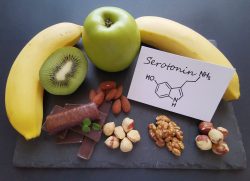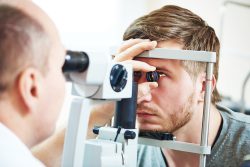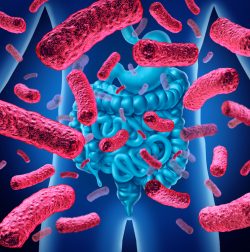Consuming Unhealthy Foods can Diminish Positive Effects of Healthy Diet
 It is well known that consuming a healthy diet such as the Mediterranean diet produces a positive impact on health. However, little is currently known about the possible effects of also consuming unhealthy foods along with an otherwise healthy diet. Researchers at the Rush University Medical Center have shown there are diminished benefits of consuming a healthy diet with those who also consume unhealthy foods fairly often.
It is well known that consuming a healthy diet such as the Mediterranean diet produces a positive impact on health. However, little is currently known about the possible effects of also consuming unhealthy foods along with an otherwise healthy diet. Researchers at the Rush University Medical Center have shown there are diminished benefits of consuming a healthy diet with those who also consume unhealthy foods fairly often.
When a healthy diet that includes fruit, vegetables, whole grains, legumes and fish, similar to the Mediterranean diet, is combined with sweets, fried foods, red meat from grain fed animals, and refined grains, benefits will diminish.
The team that conducted the observational study utilized 5,001 older adults who lived in Chicago and were also part of the Chicago Health and Aging Project (a cognitive health evaluation in adults over the age of 65 which was conducted from 1993 to 2012). The study participants were asked to complete a cognitive assessment questionnaire every three years. The questionnaire tested basic information for memory and processing skills. The participants were also asked to fill out a questionnaire in regards to the frequency with which they ate 144 food items.
The team then analyzed how close each of the participants followed a Mediterranean diet which included the daily consumption of vegetables, fruit, olive oil, legumes, potatoes, fish and unrefined cereals and also a moderate consumption of wine. The team additionally assessed how much the participants followed a Western type diet which included refined grains, fried foods, red and processed meats, sweets, pizza, and whole fat dairy products. Scores of zero to five were assigned for each food item in order to compile a total Mediterranean diet score for every participants along a range of zero to 55.
The team examined the association between the Mediterranean diet scores and changes that occurred in participants global cognitive function, perceptual speed, and episodic memory. Participants who showed slower cognitive decline through the years of follow-up were ones who had adhered closest to the Mediterranean diet and also limited foods that are typical with a Western diet. The participants who consumed more of the Western diet showed no beneficial effect of healthy food items in slowing down cognitive decline.
The team noted that there wasn’t any significant interaction between sex, age, education, or race and the association to cognitive decline in either low or high levels of the Western diet foods. Also included were models for body mass index, smoking status, and a variety of potential variables such as cardiovascular diseases, and findings remained the same.
Western diets can adversely affect cognitive health. Participants who showed a high Mediterranean diet score when compared to participants who had the lowest score, were equal to being 5.8 years younger in cognitive age.
The more often people can include berries, green leafy vegetables and other vegetables, fish and olive oil into their diets, the better it will be for aging bodies and brains. A variety of studies have shown that fried foods, red and processed meats, and lower whole grain consumption are linked to faster cognitive decline in aging adults and higher inflammation. In order to benefit from healthy diets such as the Mediterranean diet, people need to limit their consumption of other unhealthy and processed foods.
To view the original scientific study click below
Unhealthy foods may attenuate the beneficial relation of a Mediterranean diet to cognitive decline.



 A University of Otago, New Zealand, study has found that three pillars of health which are exercising, quality of sleep and eating raw vegetables and fruit, promotes better health mentally and overall well-being feeling in younger adults. And the research found that the strongest predictor was better quality of sleep than sleep quantity.
A University of Otago, New Zealand, study has found that three pillars of health which are exercising, quality of sleep and eating raw vegetables and fruit, promotes better health mentally and overall well-being feeling in younger adults. And the research found that the strongest predictor was better quality of sleep than sleep quantity. Plastics can have and impart to a human a variety of dangerous chemicals including endocrine disrupting chemicals (EDCs) that pose a threat to human health. A new report has reported the dangerous health effects of contamination that is widespread from the EDCs in plastics.
Plastics can have and impart to a human a variety of dangerous chemicals including endocrine disrupting chemicals (EDCs) that pose a threat to human health. A new report has reported the dangerous health effects of contamination that is widespread from the EDCs in plastics. According to new research at University Hospital A Coruna Spain, the time required to climb four flights of stairs provides an excellent indicator of heart health. Cardiologists use climbing stairs in a physical exam for that purpose.
According to new research at University Hospital A Coruna Spain, the time required to climb four flights of stairs provides an excellent indicator of heart health. Cardiologists use climbing stairs in a physical exam for that purpose. It is well known that intestinal health has a close link with healthy functioning of the brain. Researchers from the University of Tsukuba in Japan are now suggesting that normal sleep patterns may be influenced by gut bacteria through the ability to help create important chemical messengers in the brain such as dopamine and serotonin.
It is well known that intestinal health has a close link with healthy functioning of the brain. Researchers from the University of Tsukuba in Japan are now suggesting that normal sleep patterns may be influenced by gut bacteria through the ability to help create important chemical messengers in the brain such as dopamine and serotonin. A new study from the University of Warwick and University Hospitals Coventry and Warwickshire NHS Trust, has shown that your age is not a barrier to successful weight loss. People who are obese aged 60 and over can lose an the dame amount of weight as someone younger using only changes in their lifestyle.
A new study from the University of Warwick and University Hospitals Coventry and Warwickshire NHS Trust, has shown that your age is not a barrier to successful weight loss. People who are obese aged 60 and over can lose an the dame amount of weight as someone younger using only changes in their lifestyle.  Evidence for the harmful effects of alcohol on brain health has been compelling. And now researchers in the UK and Australia have shown evidence suggesting three periods of dynamic changes in the brain that could be particularly sensitive to the harmful effects of alcohol – gestation (conception to birth), later adolescence (15 to 19 years of age) and older adulthood (over 65 years).
Evidence for the harmful effects of alcohol on brain health has been compelling. And now researchers in the UK and Australia have shown evidence suggesting three periods of dynamic changes in the brain that could be particularly sensitive to the harmful effects of alcohol – gestation (conception to birth), later adolescence (15 to 19 years of age) and older adulthood (over 65 years).  Scientists at Harvard Medical School have successfully reversed age-related vision loss in mice through turning back the time on aged retina eye cells to bring back youthful functioning of the gene. This work is considered to be the first test of the possibility to reprogram, in a safe manner, complex tissues such as nerve cells found in the eye to an earlier age.
Scientists at Harvard Medical School have successfully reversed age-related vision loss in mice through turning back the time on aged retina eye cells to bring back youthful functioning of the gene. This work is considered to be the first test of the possibility to reprogram, in a safe manner, complex tissues such as nerve cells found in the eye to an earlier age. A new study has found links between gut bacteria and the active form of Vitamin D. This study has suggested that gut bacteria may play a vital role in converting inactive Vitamin D into its active, health benefiting form. Vitamin D is essential for maintaining healthy teeth and bones and for a strong immune system. The study has revealed a new understanding of Vitamin D and how it is typically measured.
A new study has found links between gut bacteria and the active form of Vitamin D. This study has suggested that gut bacteria may play a vital role in converting inactive Vitamin D into its active, health benefiting form. Vitamin D is essential for maintaining healthy teeth and bones and for a strong immune system. The study has revealed a new understanding of Vitamin D and how it is typically measured.